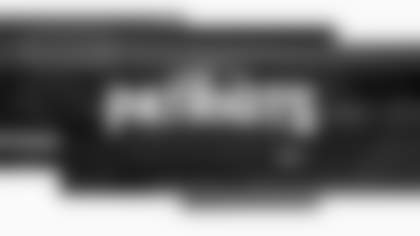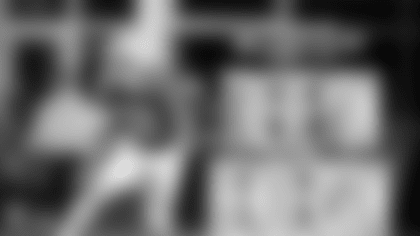This is a bye week for the Patriots, so the daily scheduling is a little different than usual. Last Thursday, coach Bill Belichick explained that the Patriots usually devote Thursdays to third down preparation. He explained his thinking in planning each week.
"Normally first and second downs are on Wednesday," said Belichick. "Third down and short yardage and two minute is sometimes on Thursday because two minute really a lot of times is a carryover from third down. Against a team like the Jets or Cincinnati, that are no huddle teams, sometimes you start that on Wednesday because kind of every down could be third down just because of the pace of the game. Then there are other teams that come in with the very specific third down package, like the Steelers for example. They're a team that runs a lot of two running backs and two receivers on first and second down, but then when you get to third down, they're a four-receiver team. That changes your whole mentality of playing defense in that situation. You probably want to separate that out. But a team that we'd use the same personnel group on all downs, you could get to earlier. Then Friday is red area, goal line and some special situations."
Belichick, known for his fondness of and skill for breaking down game film, explained the Patriots process of analyzing third downs.
"Everybody has to kind of work through their particular responsibility," Belichick explained. "So somebody is going to put all of the third down passes together. Somebody is going to put all the third down blitzes together. Somebody is going to put all of the third down coverages together, but then collectively as the staff we take that information and somebody else will do the red area. Somebody else will do goal line and short yardage.
"You divide those responsibilities among your staff to compile all of the information. That not only would include maybe they games that we have taken off and put onto our breakdowns, but it might be going back to some other games and seeing what they did against some other teams in similar situations or teams that used maybe similar formations that we do. Like on short yardage, other 3-4 teams. Or on offense, other teams that you use three receivers and a tight end as opposed to four receivers where you might be getting a different defensive package. Things like that.
"Somebody is responsible to bring it all together and kind of have all of the information assembled, but then each person - the running back coach, the offensive line coach, the quarterback coach, the receiver coach, they still have to prepare their group for those situations as well, so they study it too."
Ok. So, in three days of practice for an upcoming game, the Patriots usually devote one whole day solely to practicing theoretical third downs. That doesn't include all the time it takes the whole staff to compile the information and explain it to each other.
Seem like a lot of work to be putting into a single category? Just wait.
In last Sunday's game against Miami, there were 127 total plays. Of those 127 plays, 29 were third down plays.
Some simple math shows that 33 percent of the Patriots practice week was devoted to roughly 23 percent of the plays that actually took place on the field, or one third of the week was spent studying and planning for fewer than one quarter of the game's plays. Keep in mind this doesn't include all the time required to compile info on the tendencies.
Perhaps the discrepancy isn't jumping out at you.
Take Week 4's game at Cincinnati. In that game there were 123 total plays, 24 of which were third downs. So about 20 percent of the plays were third downs. But Belichick said the Patriots might devote Wednesday and Thursday to third down tendency. If, in fact, that was the case, then 66 percent of that week's prep time was spent practicing for about 20 percent of the game.
So why all the attention?
Belichick indirectly explained today.
"We have plays that we would call in a one down situation. Let me put it that way," said Belichick. "It could be third-and-three in your own 20. That could be the same play as fourth-and-three at midfield. So we definitely do that. We talk about that before the game, you know, fourth-and-one, fourth-and-two, fourth-and-three, could be fourth-and-goal on the five. That's probably a different play than fourth-and-two out in the field. Philosophically, whether you want to run for it, whether you want to throw for it. Or maybe it's a certain matchup where you would lean one way or the other. You know. If we put this group in and they put that group in, we'd run. If they put a different group in we'd throw. I mean it could go that way too. But yeah, I think that's part of the pregame strategy and pregame meetings that we have. And the same thing defensively, you know, what are our, what I would say, 'Got to have it' plays."
So, it seems that much of the theorizing that goes into third down plays also applies to fourth down plays. Additionally, these are the plays that are often the most pivotal in a game – Belichick's got-to-have-it plays.
What kind of a role did Bill's got-to-have-it plays have against Miami?
Both of Asante Samuel's interceptions came on third down, as did three of Troy Brown's five receptions. Samuel said after the game that he knew Welker was going to fade out on the first one, because he had studied tendencies. Another one of Brown's catches was for a touchdown, which could be defined as a got-to-have-it situation.
Asked about the correlation between Brown's receptions and third downs, Belichick responded, "Yes, he's definitely in there on those plays. Like on the scramble situation, the first third down (of the game), when you're the quarterback, you're moving around a little bit trying to find somebody open and you scan the field and you see one guy come open, that's Troy getting open, which he did a nice job on that play. We were really trying to throw him the ball out in the flat and he kind of adjusted his route and scrambled a little bit and got open. I know Tom has a lot of confidence in Troy and he should. Troy has made a lot of big plays for us and Troy has the ability to get open and find open areas."
Third down efficiency seems to be a good indicator of dominant play. In three of the Patriots four wins this season, they converted more third downs than their opponents did. The Pats also converted a greater percentage of the third downs they had than their opponents. The only exception was against the Jets, where the Pats converted 57 percent of their third downs and the Jets converted 61 percent. That 57 percent conversion rate was the highest the Pats have produced all season. In their sole loss to the Broncos, Denver out-converted the Patriots, going 44 percent on third downs to the Pats 25 percent. That was the Patriots lowest third down efficiency of the season.
Still not convinced?
Of the 15 NFL teams currently boasting winning records, 11 of those teams have an average third down efficiency better than their opponents' average. Of the 14 teams with losing records, 11 have a third down efficiency worse than their opponents' average. The remaining three teams with tied records have already had bye weeks, so they've only played four games.
Sullivan, Poteat back on the street
The Patriots signed fifth-year receiver Jabar Gaffney today. They released defensive lineman Johnathan Sullivan and defensive back Hank Poteat. Sullivan was inactive for every regular season game. Poteat was signed less than two weeks ago. He's been off and on the Patriots roster during his career.
Gaffney, 25, spent his first four NFL seasons with the Houston Texans (2002-05) and has played in 64 career games with 50 starts. The 6-foot-1-inch, 205-pound wide receiver has recorded 171 career receptions for 2,009 yards and seven touchdowns, and was a regular starter for Houston in each of his four seasons with the club. Last season with the Texans, he finished second on the team with a career-high 55 receptions for 492 yards and two touchdowns while playing in all 16 games with 13 starts. In 2004, he finished second on the team as well.
The University of Florida product was selected by the Texans in the second round (33rd overall) of the 2002 NFL Draft. Gaffney is now one of the three Patriots wide receivers that went to college at the University of Florida, including Chad Jackson and Reche Caldwell. Belichick said today that the contingent of Florida receivers is nothing more than a coincidence. Additionally, Kelvin Kight, one of two practice squad wideouts, went to Florida and Doug Gabriel went to school at Central Florida. The only receiver on the active roster who didn't go to college in the state of Florida is Troy Brown. Gaffney signed with the Philadelphia Eagles as an unrestricted free agent earlier this spring. They released him during roster cut-downs in September.
Maroney still rising
Rookie running back Laurence Maroney's yards-per carry dropped from 8.3 against the Bengals to 2.1 against the Dolphins. Corey Dillon had more rushing yards than Maroney for the first time since Week 2's game against the Jets. Maroney also had his second-fewest yards in a game against Miami. Based on those facts, you might think Maroney fell off a little bit last night.
Not so, according to coach Belichick.
"I think Laurence has done a good job. Actually, I thought he ran the ball pretty well yesterday," said Belichick. "Basically, what you want from the running back is to get the yards that the play is blocked for and then whatever extra he can get on his own, that's gravy.
"There were a couple of plays there where there wasn't much there. Like we ran a trap there where there was really almost no hole at all and he ended up just kind of squeezing through there for about four yards. ou watch the play and say, 'We're not going to gain anything on this play,' and then they spot the ball and it's second-and-six. Those are good runs. That's how we try to evaluate our back, is being able to get the yards that the play is blocked for and getting the extra yardage on their own.
"What you hate to do is leave yards out there on the field and run the ball and gain two and say, 'Well, really if we had made the cut there where we should have, we would've gotten six or seven.' To me, that's leaving yardage out on the field. You don't want to do that. I think Laurence is getting better each week."










































